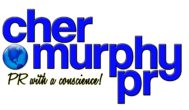
Welcome to Cher Murphy PR!
A Communications Firm - Established in 2007
Mastering the Media: What to do when the media comes calling?
As a former TV news scriptwriter and a current PR/publicity professional, I have been on both sides of the media interview game. I like to think I have a good eye for what makes a good interview source, how to conduct an interesting interview, and how to give a compelling interview. There are a few tricks of the trade that can make you come off like a pro -- which will make the reporter’s job easier and most likely translate into a better PR/publicity placement for you.
Here are some things you should keep in mind when a television camera is on you:
